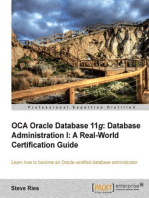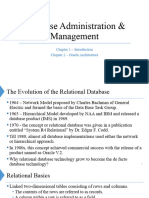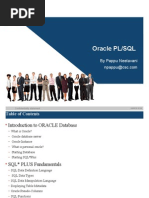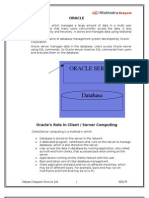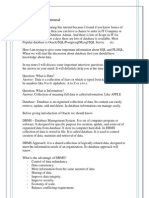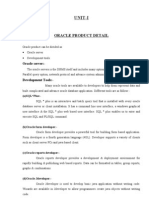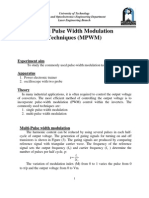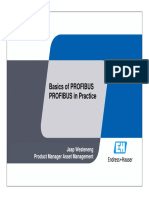Oracle-Architecture
Uploaded by
gs.mobile.dbaOracle-Architecture
Uploaded by
gs.mobile.dbaOracle Database Architecture: The Engine Behind Enterprise Data Management
Imagine a high-tech library that stores millions of books with a super-efficient
librarian who instantly finds, updates, and organizes books. That’s how Oracle
Database works—it’s a powerful system that stores, retrieves, and manages data with
unmatched efficiency and security.
Let’s dive into Oracle Database Architecture, exploring its key components, how
they work together, and why Oracle is the gold standard for databases.
11️⃣Core Components of Oracle Database
Oracle Database is built like a multi-layered system, ensuring speed, security, and
reliability. The three main components are:
📁 A. Physical Storage Layer (Data Storage)
Think of this as bookshelves in our library where all data is physically stored.
This layer includes:
Data Files: Store actual database data (like books on shelves).
Redo Log Files: Keep track of every change to prevent data loss.
Control Files: The master record of the database structure.
⚙️ B. Instance (Memory + Processes)
This is the brain of the database, where data is processed.
It consists of:
System Global Area (SGA): Shared memory for efficient data handling.
Program Global Area (PGA): Private memory for individual user processes.
Background Processes: Keep the database running smoothly (like library assistants).
🛠 C. Oracle Processes
These are like workers in the library, ensuring books are properly stored,
retrieved, and maintained.
Important processes include:
DBWR (Database Writer Process): Saves changes from memory to disk.
LGWR (Log Writer Process): Records all changes for recovery.
SMON (System Monitor): Repairs database issues automatically.
PMON (Process Monitor): Cleans up failed user connections.
2️⃣ System Global Area (SGA): The Heart of Performance
SGA is shared memory used for processing queries and caching frequently used data.
It consists of:
Database Buffer Cache: Stores frequently accessed data for faster performance.
Redo Log Buffer: Records changes before writing them to disk (ensures data
integrity).
Shared Pool: Stores SQL execution plans and parsed queries for efficiency.
Java Pool & Large Pool: Support Java operations and backup processes.
Analogy: Imagine a chef's kitchen—ingredients (data) are kept within easy reach,
reducing the need to fetch them repeatedly from the storage room.
3️⃣ How Queries Are Processed in Oracle
When a user runs a query (e.g., SELECT * FROM employees), Oracle follows these
steps:
SQL Parsing: Checks for syntax errors and security permissions.
Execution Plan Selection: Optimizer finds the best way to execute the query.
Data Retrieval: If data is in memory (SGA), it’s fetched instantly; otherwise, it's
read from disk.
Query Result Returned: The requested data is sent back to the user.
Example: Think of a restaurant—you order a dish (query), the chef prepares it
(processing), and the waiter serves it (retrieval).
4️⃣ Background Processes: Keeping Oracle Running Smoothly
Oracle has multiple background processes that handle various tasks automatically,
making it one of the most efficient databases.
Key Background Processes
DBWR (Database Writer) – Writes modified data from memory to disk.
LGWR (Log Writer) – Ensures all transactions are logged for recovery.
CKPT (Checkpoint Process) – Syncs database changes to disk at regular intervals.
SMON (System Monitor) – Repairs database failures automatically.
PMON (Process Monitor) – Cleans up failed sessions and frees up locked resources.
5️⃣ Oracle Storage Structures: Organizing Data Efficiently
Oracle uses a structured format to store and manage data efficiently.
A. Logical Storage (How Data Is Organized)
Tablespaces: The highest-level storage structure (like different sections in a
library).
Segments: Groups of related database objects (like bookshelves).
Extents: A collection of blocks for storing specific data (like book rows on
shelves).
Data Blocks: The smallest storage unit in Oracle (like individual book pages).
B. Physical Storage (Files on Disk)
Data Files: Hold actual database records.
Redo Log Files: Track all changes for recovery purposes.
Control Files: Keep the database structure information.
Analogy: Imagine a library where books (data) are placed in sections (tablespaces),
bookshelves (segments), and shelves (extents), ensuring fast retrieval and
organization.
6️⃣ Oracle Database High Availability & Recovery
Oracle ensures zero data loss and high availability using:
Redo Logs & Archive Logs: Prevents data loss in case of failure.
Flashback Technology: Allows undoing accidental changes.
Data Guard: Creates standby databases for disaster recovery.
RMAN (Recovery Manager): Automates database backups.
Example: Think of a bank—every transaction is recorded in multiple places to
prevent loss in case of a system crash.
7️⃣ Performance Tuning in Oracle Database
To ensure high performance, Oracle provides several tuning techniques:
Indexing: Speeds up searches by creating lookup structures.
Partitioning: Divides large tables for efficient access.
Optimizer Hints: Guides Oracle to choose the best query execution path.
Caching & Buffering: Reduces disk I/O for frequent queries.
Analogy: Think of a supermarket—products (data) are arranged in specific aisles
(indexes) so customers (queries) can find them faster.
8️⃣ Security Features in Oracle Database
Oracle protects data using advanced security mechanisms:
User Authentication & Roles: Ensures only authorized users can access data.
Transparent Data Encryption (TDE): Encrypts sensitive data.
Data Redaction: Masks confidential information in query results.
Audit Trails & Database Vault: Logs all database activities for compliance.
Example: Just like a bank vault, Oracle encrypts and secures sensitive information.
9️⃣ Cloud & Multitenancy in Oracle 12c & Later
With Oracle Multitenant, multiple databases (PDBs) can run inside a single
container (CDB).
Benefits:
Efficient resource sharing.
Easier database management.
Reduced storage & memory costs.
Improved security with isolation between databases.
Analogy: Think of a shopping mall (CDB) with multiple stores (PDBs) running
independently.
🔟 Conclusion: Why Oracle is the Best in the Industry
Oracle Database is a highly efficient, secure, and scalable system trusted by
banks, governments, and enterprises worldwide.
✅ Robust Architecture → Ensures high performance & availability.
✅ Advanced Security → Protects sensitive data from breaches.
✅ Self-Tuning Capabilities → Automates optimization & query performance.
✅ Multitenancy & Cloud Integration → Reduces operational costs & improves
scalability.
With its powerful architecture, Oracle remains the #1 choice for managing mission-
critical data.
You might also like
- OCA Oracle Database 11g Database Administration I: A Real-World Certification GuideFrom EverandOCA Oracle Database 11g Database Administration I: A Real-World Certification Guide4/5 (1)
- Oracle Database Architecture: Rishij Raj Srivastava / 16 - 10-2024No ratings yetOracle Database Architecture: Rishij Raj Srivastava / 16 - 10-202411 pages
- Oracle Database Architecture with Diagram - Dot Net TutorialsNo ratings yetOracle Database Architecture with Diagram - Dot Net Tutorials12 pages
- College of Computer and Information Sciences Information Systems Department IS337 - Database LabNo ratings yetCollege of Computer and Information Sciences Information Systems Department IS337 - Database Lab35 pages
- Oracle Database Administration I Oracle Server ArchitectureNo ratings yetOracle Database Administration I Oracle Server Architecture54 pages
- Database Administration and Management Lecture 3No ratings yetDatabase Administration and Management Lecture 320 pages
- The Oracle 9i DBA Fundamentals 1 Cram SheetNo ratings yetThe Oracle 9i DBA Fundamentals 1 Cram Sheet2 pages
- Oracle Database 11g - Underground Advice for Database Administrators: Beyond the basicsFrom EverandOracle Database 11g - Underground Advice for Database Administrators: Beyond the basicsNo ratings yet
- Databases: System Concepts, Designs, Management, and ImplementationFrom EverandDatabases: System Concepts, Designs, Management, and ImplementationNo ratings yet
- Oracle Database Mastery: Comprehensive Techniques for Advanced ApplicationFrom EverandOracle Database Mastery: Comprehensive Techniques for Advanced ApplicationNo ratings yet
- installation-and-configuration-guide-exadata-database-machine-dbminNo ratings yetinstallation-and-configuration-guide-exadata-database-machine-dbmin323 pages
- Multi Pulse Width Modulation Techniques (MPWM) : Experiment Aim0% (1)Multi Pulse Width Modulation Techniques (MPWM) : Experiment Aim4 pages
- Skylight Element LT v7.9.4 Release NotesNo ratings yetSkylight Element LT v7.9.4 Release Notes119 pages
- Concurrency: Deadlock and Starvation: Ninth Edition, Global Edition by William StallingsNo ratings yetConcurrency: Deadlock and Starvation: Ninth Edition, Global Edition by William Stallings69 pages
- Computer Organization Architecture MCQ - Avatto-Pahe15No ratings yetComputer Organization Architecture MCQ - Avatto-Pahe152 pages
- Multi Level, Multi Transition & Block CodesNo ratings yetMulti Level, Multi Transition & Block Codes31 pages
- 3BSE020926-510 en S800 I O Fieldbus Communication Interface For PROFIBUS DP DPV1No ratings yet3BSE020926-510 en S800 I O Fieldbus Communication Interface For PROFIBUS DP DPV1120 pages
- Signal Line 256 Gray Level 3 Channel Constant Current LED Driver ICNo ratings yetSignal Line 256 Gray Level 3 Channel Constant Current LED Driver IC8 pages
- How To Structure An ML Project For ReproducibilityNo ratings yetHow To Structure An ML Project For Reproducibility27 pages
- Testability For Resistive Open Defects by Electrical Interconnect Test of 3D ICs Without Boundary Scan Flip FlopsNo ratings yetTestability For Resistive Open Defects by Electrical Interconnect Test of 3D ICs Without Boundary Scan Flip Flops2 pages
- Objective Questions For Computer NetworksNo ratings yetObjective Questions For Computer Networks3 pages
- Basics of Profibus Profibus in Practice v111100% (1)Basics of Profibus Profibus in Practice v11144 pages



